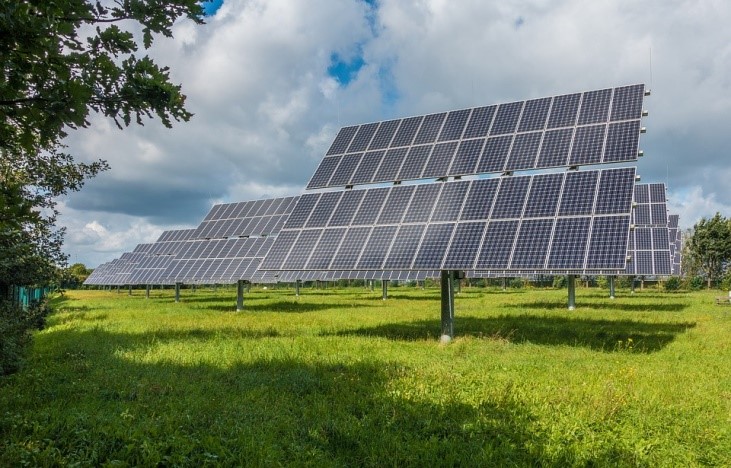During my experience working as a solar photovoltaics (PV) provider in Sri Lanka I have come to realize that there are greater benefits to be achieved with a solar PV installation that just renewable energy.
The above image shows an 88.2 kW solar PV installation at an Ayurvedic resort in Sri Lanka which we installed. The system was designed to provide over half the required energy to the site. In addition the system and its subsequent carbon savings was part of the marketing campaigns for the resort.
Additionally to improve on their sustainability practices the resort provided a 10% discount to all guests who didn’t use their air conditioning, which was the largest energy consumer per guest.
If you think you have an opportunity for solar PV, I have put together a few simple steps and guidelines to help you develop a plan and achieve more from a solar PV installation.
Over the last decade, I’ve seen renewable energy sources become a highly competitive source of energy worldwide, now accounting for nearly 30% of global electricity output. Solar photovoltaics (PV) is the fastest growing renewable electricity generation source.
The increasing adoption of solar PV has led to greater research in developing higher capacity modules with more reliable and stable power output. As the world deals with the climate crisis, nations and organizations are aligning towards a more sustainable future, but it is in everyone’s hands to be part of the Net Zero future.
To reduce carbon footprint, each individual and organization can take measures by reducing their consumption and generating what they need using renewable energy. Most organizations and homes have unutilized roof space, so it is an ideal opportunity to invest in solar PV.
A well-planned solar PV system can be a hassle-free renewable energy source and more.
Follow these steps, measures and guidelines to best utilize your solar resources and get the most out of a PV installation.

Solar PV cells can be integrated into window lights providing shading as well as generating power
PV modules can be integrated into solar tracking systems so the panels are facing the sun all day for maximum power generation.

REVIEW
The first step in the shift to renewable energy is to identify and understand the energy demand.
- Energy Monitoring
- The base to any energy management plan is to first measure the power consumption.
- Install sub meters to monitor significant energy users if needed.
- Record the energy consumption and identify patterns of consumption against usage or occupancy.
- Identify the most suitable renewable energy source
- Solar PV, unlike wind, often requires fewer planning approvals and is suitable on most sites.
- Most residential and commercial properties have sufficient unutilized roof area that can be used to meet its demand using solar PV.
- It is possible to estimate the PV power output per m2 in any given region using the global solar atlas to identify the available solar resource.
- Identify suitable roof location
- A suitable roof space would have the most amount of sunlight without any shading impediments for the majority of the year. In addition, depending on the region, the angle of the solar PV module must also be considered for maximum efficiency.
- It is necessary to consider maintenance and cleaning requirements; for example, a kitchen exhaust or birds roosting may foul the panels more often than normal.
- The inverter generates heat when operating especially under high load. Therefore, proper ventilation or cooling is required to ensure the longevity of the inverter.
- Technical specification
- Different PV technologies are available on the market including thin film, Mono-crystalline, Poly-crystalline, and Double glass modules.
- To choose the most appropriate technology, technical, economic and operational considerations need to be taken into account. Thin film modules perform better in low light conditions. Double glass modules offer better protection against chemical and salt mist deposits. Poly-crystalline modules are often lower cost compared to other technologies due to lower power output; this may be sufficient if excess roof space is available.
- Roofs are an underutilized asset, and it is an ideal source for power generation, which brings several benefits against the global climate crisis.
- Land use is one of the major contributors to global warming; therefore, the utilization of land for solar PV or any power plant is less sustainable than roof mounted solar PV.
- By generating power at the source of consumption, it is possible to mitigate transmission losses. Therefore, using rooftop solar adds to the sustainability of the energy sector by reducing energy waste.

Think carefully about location and layout. The solar PV module at the back of this picture is being shaded by the palm tree, which will affect the efficiency of all the modules in the sting. For a significant part of the year, the tall building to the west of the modules will also cast a shadow after midday causing significant generation reduction. To maximize return on investment, think carefully about achieving unobstructed roof space demarcated for any solar PV project.
Fact - The average carbon foot print for a solar PV system is 6gCO2e/kWh compared to coal (future proofed with carbon capture and storage CCS) at 109gCO2e/kWh, gas (with CCS) at 78gCO2e/kWh and hydro at 97gCO2e/kWh. This incorporates factors in the total CO2 emitted in manufacture, construction, fuel supply, generation decommissioning of a system.
REDUCE
Reduce energy waste and improve energy efficiency so you’re only using what is needed.
- Reduce energy consumption through implementing an energy management plan
- Energy reduction can be accomplished by simple cost effective measures; for example by ensuring equipment is switched off when not used.
- Look into the stakeholder behaviours, as much as technical upgrades to identify opportunities to save energy.
- Significant energy savings can be made by using solar thermal to heat water. For residential requirements, a solar thermal system can adequately meet the hot water requirements and mitigate the energy consumed by water heaters. In an industrial setting, a solar thermal system can supplement boilers with hot water, thereby reducing the energy consumed. When planning a solar PV system, remember to leave adequate space for a solar thermal system if it’s a viable option in your region. Keep in mind to factor in any shadow from the water tank of the solar thermal system.
- A proper mapping of future energy demand using historic consumption data can help with proper sizing of the solar PV system. There are several, more technical factors that an installer will consider when sizing a solar PV system.
- Solar PV has economies of scale. Fixing a larger PV capacity will provide a better rate per kW and therefore have a shorter payback period if the energy generated is utilized or sold.
- Reducing the energy demand can allow for a smaller solar PV system as the capital expense of a solar installation is high.
- Remember to factor in the annual efficiency reduction of silicon solar PV modules.
- By plotting the future energy demand increase, a suitable system can be sized to meet the future requirement.
- If a larger solar PV installation is not affordable, then consider installing only the required inverter with adequate PV modules to meet the current demand. PV modules can later be added to meet additional demand.
- Oversizing a PV system can be done according to the inverter manufacturer’s specification to allow for a greater energy generation without having to have a larger inverter capacity. By oversizing the DC capacity, the inverter will operate at a higher efficiency and will have lesser harmonic resonance in the power supply. By generating more power, the unit cost of energy can be reduced thereby having better financial return.
- If possible, use the direct DC power output from the solar PV modules for DC motors, refrigerators and other machinery to eliminate conversion losses.
REUSE
Use best practice knowledge and site specific energy data to plan out the most suitable solar PV system.
- Ask local installers about their experience and knowledge gained by carrying out installations in the area. This will provide insight into best practices and local area specific knowledge.
- Talk to customers and look to use a locally available service provider with a good record of addressing breakdowns fast.
- Ask for best practice methods to ensure the system is designed with ease of maintenance in mind.
- Identify the best interconnection methods, available power purchase agreements and available subsidies for PV installations.
- The visual impact of solar PV has now become a positive attribute. A neat and well installed solar PV system represents added value to a property and the occupant’s commitment to a more sustainable future. Some installations are carried out with a rack system on the roof to obtain the optimum angle which will impact negatively on the aesthetics. Having a flush mounted solar PV installation gives the best visual outcome but may have a reduced generation efficiency due to the angle of the roof. Therefore, it is necessary to calculate the direction and the angle of the roof and compare the efficiency loss VS having a rack mounted system. Rack mounted systems during high winds tend to get pulled up from the roof due to its angle as opposed to flush mounted systems. Therefore, a flush mounted system has an added benefit both aesthetically and structurally.
RECYCLE
Promote your solar PV system to get further benefits in energy saving and to motivate all stakeholders into adopting sustainable behaviors.
- After installation ensure that all stakeholders are aware of the sustainability measures and benefits in place.
- Utilize the completed project to re-engage all stakeholders on better sustainability practices they could do themselves.
- Keep track of local energy consumption, energy generation and emissions savings. Put into context the savings in financial terms or a form that is easily comprehensible i.e., Volume of CO2 emissions saved in terms of balloons, or annual emissions of an average sized vehicle.
- Majority of the solar PV modules can effectively be recycled. Nearly 80% of the hardware can be physically separated and recycled along with nearly 85% of the silicone material from silicone base solar PV modules. Therefore, decommission of a solar PV system can be carried out very effectively and sustainably.
RETHINK
Continually monitor the energy consumption and generation and make changes to get the best benefits from the solar PV installation both in term of renewable energy and energy efficiency.
- Reschedule your energy consumption patterns with the availability of solar as to better utilize the generated power.
- If there are any changes in consumption patterns which provide a better financial incentives, rethink on how to swap to a more suitable power purchase agreement or interconnection method.
- Monitor the energy generation and carry out regular maintenance when required to maintain proper generation from the solar PV system.
SUMMARY
Switching to a renewable energy source is an ideal way to reduce your carbon footprint on the road to Net Zero.
As solar PV installation is a long-term investment, it is necessary to consider the many options available to fully earn the best return on investment for your organization.
Proper planning can also help reduce the capital investment of a solar PV project, and help achieve better yield and lower maintenance costs.
Continually monitoring, improving and maintaining a system will help achieve the expected returns.
By following these simple steps, the solar PV installation can also bring about changes in energy efficiency, behavior change, help better understand your energy consumption and carbon footprint, along with the switch to a low carbon energy source.

Written by Praveen Bandara

